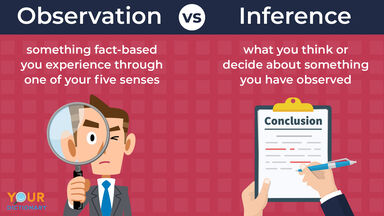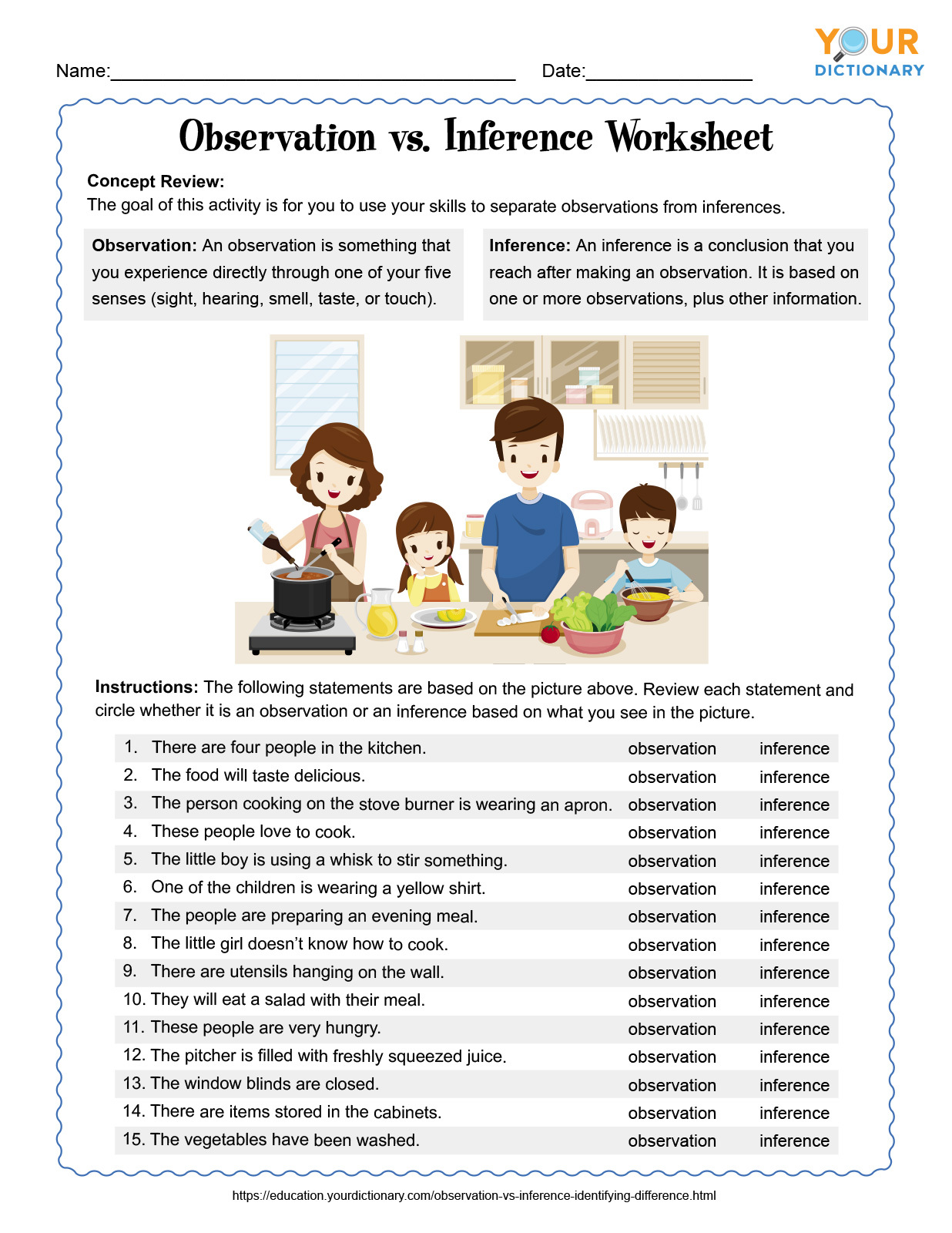Difference Between Inference And Observation
Observation vs. Inference: Identifying the Divergence
It's important for students to learn what observations and inferences are, also as to be able to tell the divergence between them. Teaching these concepts starts with definitions, but students too need to be able to apply what these words mean to real-life scenarios. Apply these activities to help your students learn how to differentiate between ascertainment vs. inference.
 ascertainment versus inference
ascertainment versus inference
Observation vs. Inference: Basic Definitions
The words observation and inference are related concepts, but they are not the aforementioned. Observations are based on factual sensory information, while inferences are conclusions that are based on observations.
Observation Definition
An ascertainment is something that you experience directly, through one of your five senses (sight, hearing, smell, gustation, and touch). Observations exercise not involve making assumptions, guessing or otherwise assigning meaning beyond what you directly feel. They are fact-based, as they but include your direct feel. At that place are many examples of observations.
Inference Definition
An inference is a conclusion that you lot reach after an ascertainment. It is what y'all retrieve or make up one's mind about something that you have observed. Inferences involve drawing conclusions in order to assign meaning to what was observed. Inferences are based on other data beyond just the observation, such equally context clues, past experience, or other factors. There are many examples of inferences.
Making Sense of the Deviation
To help students understand the difference between observations and inferences, get through a few examples with them. Link an observation direct to one of the five senses, so, give an example of an inference that could be fabricated based on the observation.
| Sense | Observation | Inference |
| sight | The sky is blue. | The weather is pleasant. |
| hearing | I hear someone calling my name. | I must be late for dinner. |
| smell | There is an unpleasant aroma outside. | Someone must have forgotten to have out the trash. |
| taste | This pickle has a sweet taste. | This must be a "bread and butter" pickle. |
| touch | The dog feels fluffy to the bear on. | The canis familiaris must shed a lot. |
Observation vs. Inference Worksheet
For further reinforcement, assign students to complete this printable observation and inference worksheet. The worksheet below features a picture of several people preparing a meal in the kitchen. Students will be tasked with reviewing the pic and a series of statements to determine if each statement is an observation or an inference. A complete reply key is included.

View & Download PDF
Observation vs. Inference Activeness
Once students are familiar with the concepts of observation and inference, use this two-part educational activeness to reinforce and help them acquire to apply their new knowledge.
Part 1: Outset With Observations Only
Start with an activeness that is based solely on making observations, to be sure that students can practice describing things without making inferences about what they have observed. Apply an object that students are familiar with, that you lot have on paw in the classroom or that y'all can easily show via an image. A plant or desk could piece of work, as well as any other item advisable for students to describe.
- Explain to students that their chore is to provide observations of an item that you lot will evidence to them.
- Tell them that their claiming is to make a list of five observations about the detail, beingness sure to just write only what they tin can directly notice using one or more of their five senses.
- Show students the item and let them know when to begin. Optionally, you may want to set a predetermined time limit. If then, allow them know how long they will have to complete the activity. Ten minutes is a good timeframe to consider.
- When the students have finished, call on them i at a time to share what they came up with. Lead a discussion in which yous reinforce right answers and provide corrective feedback for whatever that are incorrect.
- Write each reported observation on the board and inquire students to raise their paw if their list besides included the aforementioned observation. Write the total number for each observation on the board.
- In cases where students share inferences rather than observations, ask questions to get students to reflect on what ascertainment(due south) the reported inference was based on, then add the observation(s) to the board if not already listed.
To conclude the showtime part of the exercise, pb a class give-and-take that includes a review of the definition of observation and an opportunity for students to share what they learned from this activeness. Leave the observations on the board, equally they'll exist needed for office 2 of the activity.
Part 2: Move From Observation to Inferences
Once students accept completed the observation-only activity, build on what they have done with an do focused on drawing inferences from the observations made in the beginning part of this activity. First by reviewing the definition of inference. Discuss, then segue into a group activeness.
- Explicate to students that they will work in a pair or minor group. Their goal volition be to identify inferences that can be made based on the observations from the start part of the activeness.
- Before dividing students into groups, practice as a class using the tally totals for each ascertainment from the first part of the action. Indicate out that those totals are observations, then lead a discussion in which students are asked to make inferences based on those numbers. Use a few examples to become them started.
- For the ascertainment that has the highest tally, you lot could infer that this characteristic of the item is its most obvious feature.
- For the ascertainment with the everyman tally, you could infer that this characteristic of the particular is its least obvious feature.
- After the group word, let students know that it's their turn to brand inferences about the item. Tell them that their goal is to come with at least three inferences about the item, beingness certain to base their inferences on the observations already fabricated.
- Split up students into pairs or minor groups of no more than four participants, and give them about xv minutes to collaborate on what inferences they tin can draw about the object. Check-in with the groups, offering suggestions (if needed) to spur discussion.
- When time is upwards, call on each group to share their favorite of all the inferences the group came up with. Lead a discussion about which observations were used to draw the inference, too equally other information that they used.
To conclude this part of the activity, lead a discussion well-nigh the feel of making observations and applying inferences. Ask students to share how they tin use what they learned in their daily activities and school work. If they don't come up up with options right away, give them some context. For case, ask how observations and inferences could help keep them from jumping to incorrect conclusions about other people, or how they can exist used to aid strategize when playing games or participating in sports.
Distinguishing Observations and Inferences
Instruction students how to tell the divergence between inferences vs. observations will help them master of import critical thinking skills. They'll continue to use this knowledge throughout all of their years in school, and across into adulthood. Once students have learned these concepts, you may desire to outset introducing them to the scientific method.
Difference Between Inference And Observation,
Source: https://education.yourdictionary.com/teachers/activities-lesson-plans/observation-vs-inference-identifying-difference
Posted by: fitzgeraldlecous.blogspot.com


0 Response to "Difference Between Inference And Observation"
Post a Comment